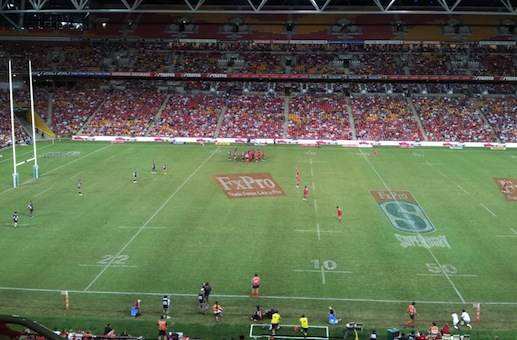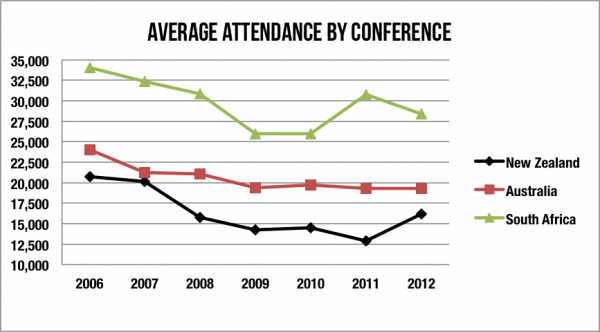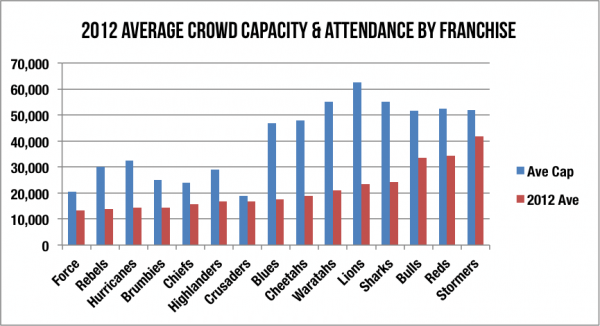After my little boasting session last week about the Reds’ crowd numbers, quite a few people asked me what these figures looked like in comparison to other conferences and competitions. (Well, three people actually, but I was interested too.) So I went in search of numbers.
- Australian Super Rugby crowds are bigger than New Zealand’s
- More people per capita go to Super Rugby games in Australia than in South Africa
Again, I have a few clarifying statements to make.
To come up with these averages I have sourced individual game data, where I could, and then calculated the averages. There are some serious gaps in the data. I am fairly comfortable with 2009 to 2012 (despite the Cheetahs and Chiefs having some counting difficulties in 2011). For the 2006 to 2008 seasons, however… hmmm, well…. If you try to hang your hat on those years, the hooks might well fall off the wall.
For this reason I have tended to concentrate on the 2011 and 2012 figures. This, and the rather significant change in the structure of the competition as a result of the expansion to 15 teams.
Again, I have used figures for just the regular round games and have not included finals. Some of the attendance figures were fairly obviously estimates: nice round neat figures that appear more than once. To add to this, I learnt that in some places they count ticket sales rather than people actually through the gate. So, if you own a season ticket, but did not go to a particular game, you will still have been counted as attending. This of course will have an effect on the accuracy, but let’s run with it and see where we end up.
First I’ll have a look across the three Super Rugby conferences. (In a second article I’ll compare Super Rugby with the Heineken Cup.)
Was this what I was expecting? Sort of, but why is it so?
First, this is live game attendance, not total audience. I would expect if I was to chart the television viewer numbers the chart could look a little different with Australia languishing at the bottom of the heap. Although pay television is the only broadcaster of Super Rugby in all three countries, I have a feeling that the TV audiences in the land of the long white cloud and the home of biltong might have us on that front.
Oh well, we can feel better and gloat a little that more of Aussies attend games in the flesh then the Kiwis. Or can we? Does the fact that New Zealanders have the ITM Cup mean they are have to spread their money across more games and therefore don’t attend as many of the Super Rugby games?
Per capita figures show a very different story. With an increase in total attendance of some 37 per cent from 2011 to 2012, New Zealanders certainly show their passion for the game with more than one in seven people attending a Super Rugby regular season fixture during 2012. Australia, on the other hand, sends one in 33, and South Africa one in 50. The middle child again….
So let’s now have a little squiz at ground capacity. Calculating a weighted average capacity for the games we find that New Zealand had an average game capacity a touch over 30,000, Australia 36,500 and South Africa 53,500. So with the highest population and largest capacity you would expect the South African teams on top.
And yes, all five of the South African sides are in the top seven, which is rounded out by the Reds and the Waratahs. (Time for a little more gloating from this Reds supporter.) The Reds were second only to the Stormers in average crowd attendance for the 2012 season. And, for the record, we were third behind the Stormers and the Bulls in 2011, and led the Australian conference. Mighty good effort, I say!
Whilst compiling these figures I did notice that the New Zealand teams play at least one of their home games a year away from their home ground. For example, during the 2011 and 2012 seasons the Hurricanes have played in New Plymouth, Napier and Palmerston North in addition to their traditional home ground of Wellington. Putting aside the horror that was the Crusaders’ season in 2011, I wonder if this is a conscious decision of the NZRU and/or the franchises to maintain contact with the smaller communities?
These secondary grounds are generally of a smaller capacity. The Crusaders are the only team whose secondary ground in 2012, McLean Park in Napier (22,000), was actually larger than their home ground, AMI Stadium Addington in Christchurch (18,600).
Speaking of the Crusaders’ 2011 annus horribilis, their average attendance dropped significantly from 2010 to 2011. I would guess I am not alone in realising that this is because of the destruction of the old AMI ground that could hold a capacity crowd of 38,628. The new AMI stadium has an official capacity of 18,600 (though they did apparently manage to squeeze in 21,000 for the game against the Highlanders in round 15 this year). This flowed through to the dip in the New Zealand average for 2011; however, having said that, I note the Chiefs and Hurricanes also had a drop in the attendance figures for the 2011 season.
I wonder if people were saving their money for the RWC2011? If you compare the 2010 and 2012 seasons all New Zealand teams other that the Crusaders and the Blues have significant increases in their attendance. The Crusaders’ situation is because of the definite decrease in capacity, and the Blues’ is pretty much the same in the two seasons. So why the big dip in 2011?
Just as a matter of interest I then looked at the proportion of the capacity used. The Crusaders, ranked ninth in attendance average, were actually using about 88 per cent of their capacity. Wow! The Reds on average were using only just over 65 per cent of theirs, and were leading the Australian conference. On a conference-wide basis New Zealand ran at 53.5 per cent with Australia and South Africa just below 53 per cent and fairly similar (within 0.1 percentage points of each other).
An interesting note from the figures in this comparison is that the Force, despite having the lowest average attendance, are actually traveling not too bad in the usage stakes at just under 65 per cent. Not actually all that far behind the Reds. So maybe things aren’t all doom-and-gloom in the west.
The Waratahs, however, are using just 38 per cent of their capacity. Is it time to give ANZ Stadium the flick, or is this just a reflection of the troubles that are currently afflicting the franchise?
See how Super Rugby crowd sizes compare to Heineken Cup in my next article.
Thanks to Greg Peters, SANZAR CEO, for supplying some of the figures that I have used in this analysis.





